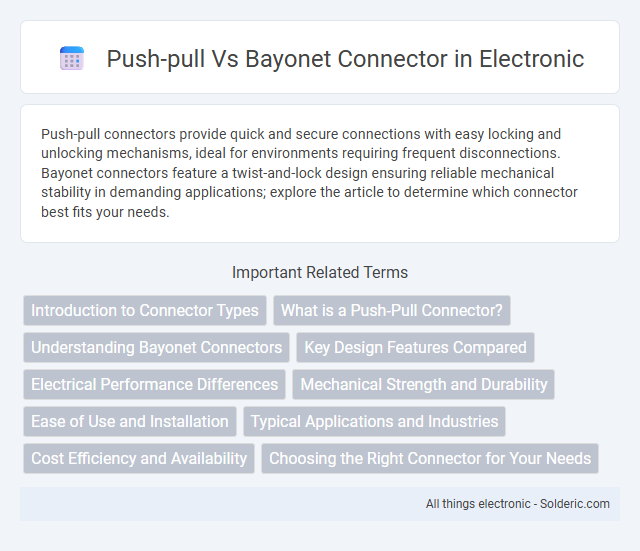Push-pull connectors provide quick and secure connections with easy locking and unlocking mechanisms, ideal for environments requiring frequent disconnections. Bayonet connectors feature a twist-and-lock design ensuring reliable mechanical stability in demanding applications; explore the article to determine which connector best fits your needs.
Comparison Table
| Feature | Push-Pull Connector | Bayonet Connector |
|---|---|---|
| Connection Type | Quick-release push-pull locking mechanism | Twist-lock with pin and slot alignment |
| Ease of Use | Simple push to connect, pull to disconnect | Requires twisting to lock and unlock |
| Locking Security | Secure locking, resistant to accidental disconnection | Strong locking, but may loosen with vibration |
| Typical Applications | Medical devices, industrial automation, instrumentation | Military, aerospace, lighting, heavy-duty equipment |
| Durability | High durability with robust metal housing | Durable but can wear out locking slots over time |
| Size & Weight | Compact and lightweight design | Generally bulkier due to locking mechanism |
| Cost | Typically higher due to precision design | Usually more affordable and simpler |
Introduction to Connector Types
Push-pull connectors feature a spring-loaded mechanism allowing quick, secure mating and automatic locking, ideal for applications requiring fast connection and disconnection. Bayonet connectors use a twist-and-lock system providing robust mechanical retention, commonly found in high-vibration environments where secure locking is essential. Your choice between push-pull and bayonet connectors depends on the need for speed, ease of use, and mechanical stability in your specific application.
What is a Push-Pull Connector?
A Push-Pull connector is a robust electrical connector designed for quick and secure mating by simply pushing the connector into place until it locks automatically. It features a spring-loaded locking mechanism that provides high retention force and vibration resistance, making it ideal for medical devices, industrial equipment, and instrumentation. Compared to Bayonet connectors, Push-Pull connectors offer faster connection and disconnection with a single hand operation while maintaining reliable contact integrity.
Understanding Bayonet Connectors
Bayonet connectors feature a simple locking mechanism using pins and slots, providing secure and quick mating ideal for applications requiring frequent connection and disconnection. Their robust design ensures reliable electrical contact in harsh environments, making them prevalent in automotive, aerospace, and medical devices. Compared to push-pull connectors, bayonet connectors excel in preventing accidental disconnection but may require more precise alignment during use.
Key Design Features Compared
Push-pull connectors offer quick-release mechanisms with secure locking, facilitating easy connection and disconnection in tight spaces, while bayonet connectors rely on a twist-and-lock design providing robust mechanical retention and resistance to vibration. Push-pull designs typically feature a smooth cylindrical body with internal latches for high-density configurations, whereas bayonet connectors incorporate external lugs and slots ensuring precise alignment and tactile feedback during engagement. Both connectors emphasize durability and reliability, with bayonet connectors often favored in rugged environments and push-pull connectors preferred for applications requiring rapid mating cycles.
Electrical Performance Differences
Push-pull connectors provide superior electrical performance with lower contact resistance and enhanced signal integrity, ideal for high-frequency or sensitive applications. Bayonet connectors offer reliable mechanical locking but may have slightly higher contact resistance, affecting signal quality in precision electronic setups. Choosing the right connector impacts Your device's efficiency by balancing ease of use with electrical connectivity demands.
Mechanical Strength and Durability
Push-pull connectors provide superior mechanical strength through secure locking mechanisms that resist vibration, making them ideal for demanding industrial and medical applications. Bayonet connectors offer moderate durability with a twist-and-lock design that ensures fast coupling but may loosen under heavy mechanical stress or repeated cycles. The robust construction of push-pull connectors enhances longevity and maintains consistent electrical contact even in harsh environments.
Ease of Use and Installation
Push-pull connectors provide a quick and intuitive connection method with a simple push-to-lock mechanism, significantly reducing installation time and minimizing errors. Bayonet connectors require precise alignment and a twist-to-lock action, which can be more time-consuming and may demand careful handling to ensure secure engagement. Your choice depends on prioritizing rapid, error-proof connections (push-pull) versus a traditional, durable locking system (bayonet).
Typical Applications and Industries
Push-pull connectors are widely used in medical devices, aerospace, and military applications due to their secure locking mechanism and ease of connection in tight spaces. Bayonet connectors find common usage in automotive, industrial equipment, and consumer electronics, where quick twist-locking and durability are essential. Both connector types support reliable electrical and data transmission across demanding environments in telecommunications and instrumentation industries.
Cost Efficiency and Availability
Push-pull connectors typically offer higher cost efficiency due to simplified assembly processes and widespread use in various industries, leading to competitive pricing. Bayonet connectors, while often more durable, may have higher upfront costs and limited availability specific to certain applications or markets. Your choice depends on balancing budget constraints with access to connectors that meet your performance requirements.
Choosing the Right Connector for Your Needs
Choosing the right connector for your needs depends on the specific application requirements such as ease of use, durability, and connection security. Push-pull connectors offer quick mating and release with high retention force, making them ideal for medical devices and aerospace where rapid and secure connections are critical. Bayonet connectors provide a twist-lock mechanism for reliable, vibration-resistant connections commonly used in military and industrial settings.
Push-pull vs Bayonet connector Infographic

 solderic.com
solderic.com